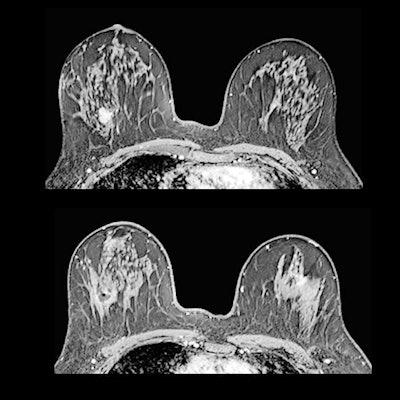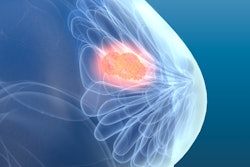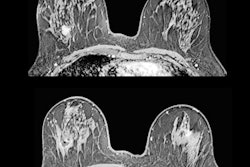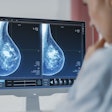
The heated debate over the pros and cons of contrast-enhanced mammography and MRI for screening women with dense breast tissue has resurfaced in the Netherlands. A new vote on the use of MRI as a screening tool is due to take place in parliament this week.
Currently, women participating in the Dutch screening program are not informed about their tissue density, and no additional MRI is officially performed during screening. While the government is now focusing on the potential of contrast-enhanced mammography for screening dense breast tissue, the Dutch Radiology Society (NVvR) and many imaging experts support immediate access to MRI for these patients.


Contrast-enhanced mammography exam of both breasts in two views. In the first two low-energy images (A, B), an ill-defined mass can be seen in the upper outer quadrant of the right breast at the location of a palpable mass in a 52-year-old patient. In the left breast, no relevant abnormalities can be detected. In the recombined images (C, D) of a contrast-enhanced mammography examination, contrast uptake can be appreciated. The recombined images show an irregular enhancing mass in both breasts -- both in the upper outer quadrant. Tissue sampling revealed a bilateral invasive breast cancer of no special type. A breast MRI examination performed prior to surgery also confirmed the presence of two irregular enhancing masses on these contrast-enhanced T1 weighted images (E: top example is the cancer in the right breast; bottom example is the left breast). All images courtesy of Dr. Marc Lobbes, PhD.
The Dutch Health Council (Gezondheidsraad) decided against implementation of breast MRI screening, and it suggested that contrast-enhanced mammography should be explored as a potential alternative through a new trial. The NVvR rejected the guidance in a statement released on 2 December.
In a dramatic twist, a member of the Ministry of Health subcommittee last week seemingly undermined the official recommendations of the Health Secretary by proposing that women with dense breast tissue undergo MRI for screening and be told about their breast density, in addition to planning for the contrast-enhanced mammography trial recommended by the Health Council. A vote on the matter is scheduled for this week.
Implementation challenges
The NVvR has welcomed the resolution, but among the Dutch imaging community, there are mixed feelings on the long-term role of both MRI and contrast-enhanced mammography in screening.
"In practice, implementation of MRI screening will have some challenges," Dr. Marc Lobbes, PhD, a breast radiologist at the Zuyderland Medical Center and the Maastricht University Medical Center in the Netherlands, told AuntMinnieEurope.com.
He lists the main challenges as the following:
- The cost of screening will increase significantly as an estimated 80,000 additional MRI exams will need to be performed each year.
- Screening radiologists might have to increase their experience as the DENSE trial (November 2019, New England Journal of Medicine) involved the most experienced Dutch MR radiologists.
- More installations will be required and need to be serviced.
- A shortage of qualified technicians exists.
- When compared with contrast-enhanced mammography, acquiring and viewing the exams is time-consuming.
Lobbes was part of the DENSE trial, which showed that by adding breast MRI after a recent negative screening mammogram in women with extremely dense breast tissue, the interval cancer rate could drop significantly. He believes that contrast-enhanced mammography has "untapped potential for screening purposes" because it is equal in sensitivity to MRI, has better specificity, is cheaper, involves faster reading times, and is much easier to learn than MRI.
"As several studies show, sensitivity is fairly equal between contrast-enhanced mammography and MRI, and contrast-enhanced mammography's specificity might even be slightly better, meaning that it has fewer false positives than MRI," said Lobbes, who is an advisor to the Dutch Health Council on contrast-enhanced mammography.
What are the pros and cons?
Contrast-enhanced mammography is much easier to implement, according to Lobbes. Four vendors now offer five commercial units, and consequently, systems can often be upgraded rather than fully replaced. Disadvantages are the use of iodine contrast agents and the use of radiation, which is 50% to 80% higher than mammography, but still within acceptable limits for breast screening, he noted.
"The council is not fully convinced that MRI screening for extreme dense breast tissue is a robust solution for the future. They want to avoid investing in expensive hardware that might be obsolete in the next 5 to 10 years and so are recommending a comparative study of CEM and MRI," Lobbes said.
The large, prospective, noninferiority study recommended by the Council will need to be accepted onto the research agenda priority list of large funding bodies, and be subject to an open call, probably in September of this year, he noted.
"Although I understand the council's conclusion and support a rapid start of such a prospective trial, as a doctor I also feel disappointment that no alternative was offered to women in the transition period," Lobbes added.
He pointed to plans underway for several large, prospective trials that aim to study the advantages and disadvantages of contrast-enhanced mammography and MRI in the screening setting, with the aim of creating a more individualized screening strategy that leverages contrast-enhanced mammography, MRI, conventional mammography, and digital breast tomosynthesis.
The NVvR perspective
The NVvR claims that the possible advantages of contrast-enhanced mammography have been overstated. Given the demonstrated efficacy of MRI in the DENSE trial, the NVvR believes that it should be implemented as soon as possible and not be delayed by the extensive research needed to assess the potential of contrast-enhanced mammography.
"Even at its best, contrast-enhanced mammography will not improve on the sensitivity of breast MRI (and likely will be a bit worse)," Dr. Ritse Mann, PhD, topical expert for the NVvR, told AuntMinnieEurope.com.
"While potentially a reduction of false-positive findings is possible, this has never been tested in a real screening setting where the focus is on detection of small and subtle lesions," added Mann, who is a breast radiologist at Radboud University Medical in Nijmegen and the Netherlands Cancer Institute, and also chair of the scientific committee of the European Society of Breast Imaging.
There are also queries over the Health Secretary's statement that evaluating contrast-enhanced mammography and subsequent implementation will take a similar time as implementing breast MRI screening at this point in time.
"While we do not disagree that evaluation of the potential of contrast-enhanced mammography in screening should be performed, we disagree that this is feasible within a very short period," noted Dr. Jeroen Veltman, PhD, breast radiologist at Hospital Group Twente (Ziekenhuisgroep Twente, ZGT) Almelo and chair of the breast section of the NVvR.
The DENSE trial lasted 10 years, and this investigation is likely to take a similar amount of time, according to Veltman.
"The Dutch breast section strongly believes it is unethical not to offer MRI to women with extremely dense breasts who would like to undergo the examination," he said. "The current advice of the Secretary leaves women without any possibility of undergoing proven better screening for years to come."



















